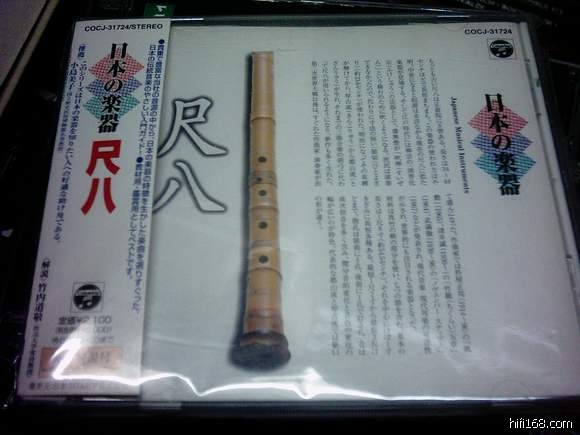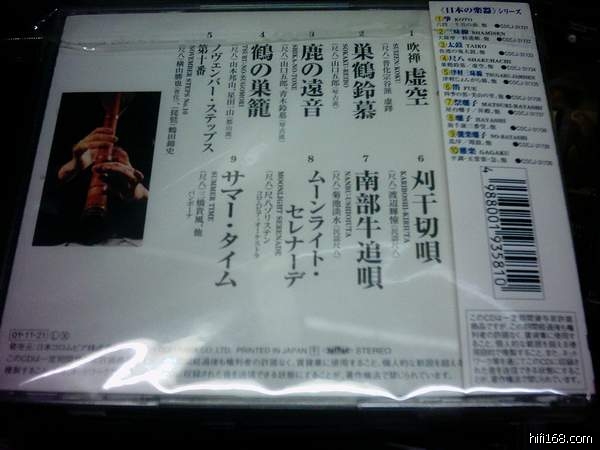横山胜也 (1934 - 2010):
横山胜也是琴古流尺八大师,由于几乎是武满彻钦定的尺八演奏家,他在西方名气很大。当然,绝不是因为武满彻才有了横山胜也他完全可以称得上是一代宗师。这里的演奏由他和萨摩琵琶大师鹤田锦史共同完成,几乎全部是古典名曲。
Katsuya Yokoyama (横山勝也,
Yokoyama Katsuya?, born in
Shizuoka,
Japan, 1934 - 21 April 2010) was an internationally renowned player and teacher of the
shakuhachi, a traditional vertical
bamboo flute of
Japan.
Katsuya Yokoyama is one of the greatest masters of the shakuhachi in Japan today. He was born in Shizuoka Prefecture in 1934 and studied Kinko-ryu and Azuma styles of music with his father, Rampo Yokoyama, and grandfather, Koson Yokoyama.
At the age of 25, Yokoyama began to study with Fukuda Rando, founder of the Azuma School and with Watazumido-doso, a legendary Fuke master who sought to synthesize shakuhachi music and spirituality within the context of Zen Buddhism. Guided by these two eminent masters, Yokoyama was able to combine the modernism of Rando with the deeply religious traditional spirit of Watazumido in his training. With this foundation, he came to develop a remarkably powerful and creative style that embodied both ends of the continuum. A true descendant of the Kinko tradition transmitted down through the generations, he also pioneered a revolution in modern music that swept across post-War Japan.
In 1960, Yokoyama completed his studies at the NHK Japanese Traditional Music Training Center and, one year later, formed Shakuhachi San-Jyuso-dan, a trio devoted to furthering new music for the instrument. In 1963, he founded the Nihon Ongaku Shudan (Japanese Music Group) and Shakuhachi Sanbon-kai (Group of Three Shakuhachi ) with Kinko master Aoki Reibo and Tozan master Hozan Yamamoto. This historic group helped to establish a new genre of music for shakuhachi trio.
Yokoyama achieved international attention for his
New York City premiere performance in November 1967, of
Tōru Takemitsu's composition
November Steps, for shakuhachi,
biwa, and orchestra, with the
New York Philharmonic, under the direction of
Seiji Ozawa (with
biwa player
Tsuruta Kinshi).
Until his death on April 21, 2010, Katsuya Yokoyama was head of the Chikushin-kai Shakuhachi Guild. He has been the recipient of many prestigious awards, amongst them the Geijutsu Sen-sho (Art Award) in 1971, the Geijutsu-sai Yushu-sho (Art Excellence Award) in 1972, the Geijutsu-sai Tai-sho (Art Festival Grand Prize) in 1973 given by the Agency for Cultural Affairs and the Ongaku no Tomo-sha Award in 1991.
In 1988, Yokoyama founded the Kokusai Shakuhachi Kenshu Center (International Shakuhachi Training Center) located in Bisei-cho, Okayama, Japan where he hosted the first International Shakuhachi Festival in 1993. This event precipitated founding of the World Shakuhachi Society and Festival held in Boulder, Colorado in 1998. At this gathering, five of the world's greatest shakuhachi masters, including Yokoyama, performed in a single venue for the first time ever.
In 2002, the Japanese government honored Katsuya Yokoyama for a lifetime of achievement by awarding him the esteemed Shiju Hosho (Purple Ribbon Medal) award.



